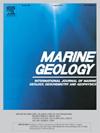南海东北部沉积物波浪重建的第四纪深水洋流流动状况
IF 2.6
3区 地球科学
Q2 GEOSCIENCES, MULTIDISCIPLINARY
引用次数: 0
摘要
中国南海(SCS)在维持太平洋和印度洋环流方面发挥着关键作用。太平洋深水从吕宋海峡进入南海东北部后,转变为深水洋流(DWC)并向西流动。深水洋流在南中国海的上涌可以流向印度洋和太平洋。然而,这种现代环流是何时以及如何在南中国海形成的仍不清楚。通过使用与大洋钻探计划在南中国海东北部边缘的油井相关联的地震反射数据,我们发现了以前未报道过的沉积波场,其起始时间可追溯到 2.6 Ma。在 2.6 Ma 到 0.7 Ma 之间,沉积波的高度从 2.0 m 增加到 7.5 m,空间范围从 630 km2 增加到 800 km2。此后,波高和空间范围分别减小到 5.5 米和 700 平方公里。考虑到沉积波的位置、形态特征和水深,我们认为这些沉积波是由 DWC 形成的。沉积波的形态变化分别与 2.6~0.7 Ma 和 0.7~0 Ma 内 DWC 的能量增减有关。我们将这一增强解释为吕宋海峡(南中国海唯一的深水门户)的狭窄和抬升所致,并推测0.7 Ma之后的减弱可能与中更新世气候转变导致的黑潮入侵减少有关。这项研究为第四纪 DWC 流体动力的演变提出了一个新的模型,有助于我们了解南中国海与太平洋之间的古海洋学联系。本文章由计算机程序翻译,如有差异,请以英文原文为准。
Flow conditions of the Quaternary Deep-water Current reconstructed by sediment waves in the northeastern South China Sea
The South China Sea (SCS) plays a key role in maintaining the circulation in the Pacific and Indian oceans. After entering the northeast South China Sea from the Luzon Strait, the Pacific Deep Water transforms into the Deep-water Current (DWC) and flows westward. The upwelling of the DWC in the SCS could outflow into both the Indian and Pacific oceans. However, when and how this modern circulation was established in the SCS remains unclear. By using seismic reflection data tied to the Ocean Drilling Program wells in the northeastern SCS margin, we have discovered fields of previously unreported sediment waves, of which the onset dates back to ∼2.6 Ma. The sediment wave heights increased from 2.0 to 7.5 m, in association with spatial extent from 630 km2 to 800 km2 between ∼2.6 Ma and ∼ 0.7 Ma. After that, the wave heights and spatial extent reduced to ∼5.5 m and 700 km2, respectively. Considering the location, morphological features and water depth, we propose that these sediment waves were formed by the DWC. The morphological changes of the sediment waves are linked to energy increase and decrease of the DWC within ∼2.6–0.7 Ma and ∼ 0.7–0 Ma, respectively. We interpret the intensification as caused by the narrowing and uplifting of the Luzon Strait that is the sole deep-water gateway of the SCS, and speculate that the post-0.7 Ma weakening was probably related to the reduced Kuroshio Current intrusion due to the middle Pleistocene climate transition. This study proposes a novel model for the evolution of the Quaternary DWC hydrodynamics, fostering our understanding of the paleo-oceanographic links between the SCS and the Pacific Ocean.
求助全文
通过发布文献求助,成功后即可免费获取论文全文。
去求助
来源期刊

Marine Geology
地学-地球科学综合
CiteScore
6.10
自引率
6.90%
发文量
175
审稿时长
21.9 weeks
期刊介绍:
Marine Geology is the premier international journal on marine geological processes in the broadest sense. We seek papers that are comprehensive, interdisciplinary and synthetic that will be lasting contributions to the field. Although most papers are based on regional studies, they must demonstrate new findings of international significance. We accept papers on subjects as diverse as seafloor hydrothermal systems, beach dynamics, early diagenesis, microbiological studies in sediments, palaeoclimate studies and geophysical studies of the seabed. We encourage papers that address emerging new fields, for example the influence of anthropogenic processes on coastal/marine geology and coastal/marine geoarchaeology. We insist that the papers are concerned with the marine realm and that they deal with geology: with rocks, sediments, and physical and chemical processes affecting them. Papers should address scientific hypotheses: highly descriptive data compilations or papers that deal only with marine management and risk assessment should be submitted to other journals. Papers on laboratory or modelling studies must demonstrate direct relevance to marine processes or deposits. The primary criteria for acceptance of papers is that the science is of high quality, novel, significant, and of broad international interest.
 求助内容:
求助内容: 应助结果提醒方式:
应助结果提醒方式:


